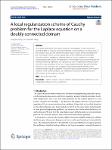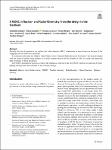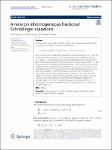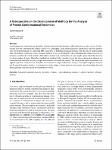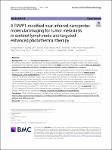Author
- Carlos, Alegría (2)
- Carlos, Seara (2)
- David, Orden (2)
- Klaus, Bretterbauer (2)
- next >
Subject
Date issued
Has File(s)
- true (287)
OER - Khoa học Tự nhiên (287)
Item Title - Ascending [/1]
Answering a question of Conway and Guy (SIAM Rev. 11:78-82, 1969), Lángi (Bull. Lond. Math. Soc. 54: 501-516, 2022) proved the existence of a monostable polyhedron with n-fold rotational symmetry for any n≥3
, and arbitrarily close to a Euclidean ball. In this paper we strengthen this result by characterizing the possible symmetry groups of all mono-monostatic smooth convex bodies and convex polyhedra. Our result also answers a stronger version of the question of Conway and Guy, asked in the above paper of Lángi. |
We propose and analyze a new class of three dimensional space models that describes infectious diseases caused by viruses such as hepatitis B virus (HBV) and hepatitis C virus (HCV). This work constructs a Reaction–Diffusion-Ordinary Differential Equation model of virus dynamics, including absorption effect, cell proliferation, time delay, and a generalized incidence rate function. By constructing suitable Lyapunov functionals, we show that the model has threshold dynamics: if the basic reproduction number R0(τ)≤1, then the uninfected equilibrium is globally asymptotically stable, whereas if R0(τ)>1, and under certain conditions, the infected equilibrium is globally asymptotically sta... |
This work introduces a novel approach for data-driven model reduction of time-dependent parametric partial differential equations. Using a multi-step procedure consisting of proper orthogonal decomposition, dynamic mode decomposition, and manifold interpolation, the proposed approach allows to accurately recover field solutions from a few large-scale simulations. Numerical experiments for the Rayleigh-Bénard cavity problem show the effectiveness of such multi-step procedure in two parametric regimes, i.e., medium and high Grashof number. The latter regime is particularly challenging as it nears the onset of turbulent and chaotic behavior. |
In statistical seismology, the Epidemic Type Aftershocks Sequence (ETAS) model is a branching process used world-wide to forecast earthquake intensity rates and reproduce many statistical features observed in seismicity catalogs. In this paper, we describe a fractional differential equation that governs the earthquake intensity rate of the pure temporal ETAS model by using the Caputo fractional derivative and we solve it analytically. We highlight that the tools and special functions of fractional calculus simplify the classical methods employed to obtain the intensity rate and let us describe the change of solution decay for large times. |
In this work, by the introduction of some parameters, a new half-discrete kernel function in the whole plane is defined, which involves both the homogeneous and the nonhomogeneous cases. By employing some techniques of real analysis, especially the method of a weight function, a new half-discrete Hilbert-type inequality with the new kernel function, as well as its equivalent Hardy-type inequalities are established. Moreover, it is proved that the constant factors of the newly obtained inequalities are the best possible. Finally, assigning special values to the parameters, some new half-discrete Hilbert-type inequalities with special kernels are presented at the end of the paper. |
The Cauchy problem of the Laplace equation is investigated for both exact and perturbed data on a doubly connected domain, i.e., the numerical reconstruction of the function value and the normal derivative value on a part of the boundary from the knowledge of exact or noisy Cauchy data on the remaining and accessible boundary, which is completely different from the Cauchy problem on a simply connected bounded region. |
We consider the transcendental entire function f(z)=z+e−z, which has a doubly parabolic Baker domain U of degree two, i.e. an invariant stable component for which all iterates converge locally uniformly to infinity, and for which the hyperbolic distance between successive iterates converges to zero. It is known from general results that the dynamics on the boundary is ergodic and recurrent and that the set of points in ∂U whose orbit escapes to infinity has zero harmonic measure. |
In this paper, we introduce a proximal point-type of viscosity iterative method with double implicit midpoint rule comprising of a nonexpansive mapping and the resolvents of a monotone operator and a bifunction. Furthermore, we establish that the sequence generated by our proposed algorithm converges strongly to an element in the intersection of the solution sets of monotone inclusion problem, equilibrium problem and fixed point problem for a nonexpansive mapping in complete CAT(0) spaces. In addition, we give a numerical example of our method each in a finite dimensional Euclidean space and a non-Hilbert space setting to show the applicability of our method . Our results complement m... |
Recently, the loss of expertise in the nuclear- and radio-chemistry (NRC) is becoming an issue of concern, because of few engaging curricula and career prospects.
To counteract this trend, the Massive Open Online Course “Essential Radiochemistry for Society” has been developed with the intent of letting young students in scientific matters discover all the benefits of NRC to society and improving their awareness of these disciplines.
The MOOC development process as well as the feedbacks collected in the first MOOC editions are analyzed by highlighting strong points and weakness of the followed strategy. |
We investigate a nonlinear equation with quadratic nonlinearities, including a nonlinear model in Silva and Freire (J. Differ. Equ. 320:371–398, 2022). Using the classical energy estimate methods, we give a necessary and sufficient condition of blow-up of solutions to nonlinear equations. We answer a problem pointed out by Silva and Freire (J. Differ. Equ. 320:371–398, 2022). |
We use the associated ground states and some sharp Gagliardo–Nirenberg inequalities. Moreover, we investigate the L2 concentration of the mass-critical blowing-up solutions. Finally, in the attractive regime, we prove the scattering of energy global solutions. Since there is a loss of regularity in Strichartz estimates for the fractional Schrödinger problem with nonradial data, in this work, we assume that u|t=0 is spherically symmetric. The blowup results use ideas of the pioneering work by Boulenger el al. (J. Funct. Anal. 271:2569–2603, 2016). |
In this paper, we propose a new inertial iterative method to solve classical variational inequalities with pseudomonotone and Lipschitz continuous operators in the setting of a real Hilbert space. The proposed iterative scheme is basically analogous to the extragradient method used to solve the problems of variational inequalities in real Hilbert spaces. The strong convergence of the proposed algorithm is set up with the prior knowledge of Lipschitz’s constant of an operator. Finally, several computational experiments are listed to show the applicability and efficiency of the proposed algorithm. |
The analysis developed in this paper also allows to investigate the relation between a Riesz-type of Schrödinger–Newton systems and a logarithmic-type of Schrödinger–Poisson systems. Furthermore, this approach can overcome some difficulties resulting from either the nonlocal term with sign-changing and unbounded logarithmic integral kernel, or the critical nonlinearity, or the lack of monotonicity of f(t)t3. We emphasize that it seems much difficult to use the variational framework developed in the existed literature to study the above problem. |
This research concerns the development of a parametric format for the semantic description of 3D city models. Following a brief review of the state of the art, the case study is introduced (an historical city block in Catania) whose geometries will be semantically organised through the VPL Grasshopper. |
We introduce a large class of concentrated p-Lévy integrable functions approximating the unity, which serves as the core tool from which we provide a nonlocal characterization of the Sobolev spaces and the space of functions of bounded variation via nonlocal energies forms. It turns out that this nonlocal characterization is a necessary and sufficient criterion to define Sobolev spaces on domains satisfying the extension property. We also examine the general case where the extension property does not necessarily hold. In the latter case we establish weak convergence of the nonlocal Radon measures involved to the local Radon measures induced by the distributional gradient. |
Analysing protein conformational ensembles whether from molecular dynamics (MD) simulation or other sources for functionally relevant conformational changes can be very challenging. In the nineteen nineties dimensional reduction methods were developed primarily for analysing MD trajectories to determine dominant motions with the aim of understanding their relationship to function. Coarse-graining methods were also developed so the conformational change between two structures could be described in terms of the relative motion of a small number of quasi-rigid regions rather than in terms of a large number of atoms. |
We consider a lot-sizing problem with set-ups where the demands are uncertain, and propose a novel approach to evaluate the inventory costs. An interval uncertainty is assumed for the demands. Between two consecutive production periods, the adversary chooses to set the demand either to its higher value or to its lower value in order to maximize the inventory (holding or backlog) costs. A mixed-integer model is devised and a column-and-row generation algorithm is proposed. Computational tests based on random generated instances are conducted to evaluate the model, the decomposition algorithm, and compare the structure of the solutions from the robust model with those from the determini... |
We consider a 3d multi-structure composed of two joined perpendicular thin films: a vertical one with small thickness han and a horizontal one with small thickness hbn. We study the asymptotic behavior, as han and hbn
tend to zero, of an eigenvalue problem for the Laplacian defined on this multi-structure. |
TMVP1 is a novel tumor targeting polypeptide screened by our laboratory with a core sequence of five amino acids LARGR. It specially binds to vascular endothelial growth factor receptor-3 (VEGFR-3), which is mainly expressed on neo-lymphatic vessels in sentinel lymph node (SLN) with tumor metastasis in adults. Here, we prepared a targeted nanoprobe using TMVP1-modified nanomaterials for tumor metastasis SLN imaging. |
This article aims to provide a virtual reconstruction of the skyscraper Hotel Attraction based on the original documentation, which makes it possible to analyze the project and propose hypotheses regarding the contradictory information in the original drawings. The geometry of the project has been defined using a physics-based simulation, emulating Gaudí’s methodology in his models. To define the curves, a model based on weighted hanging chains has been generated, using a system with springs and particles. |






